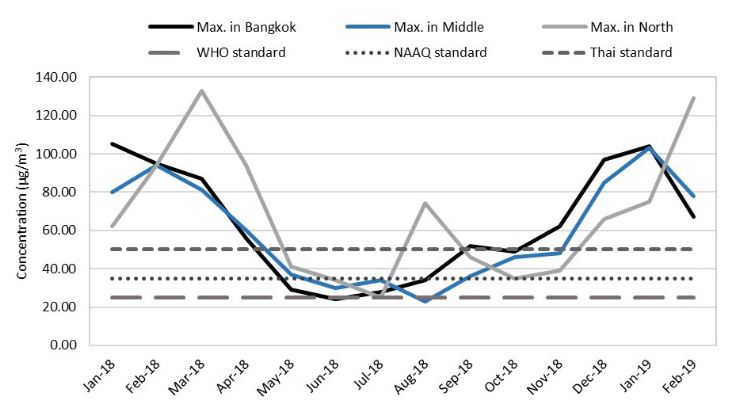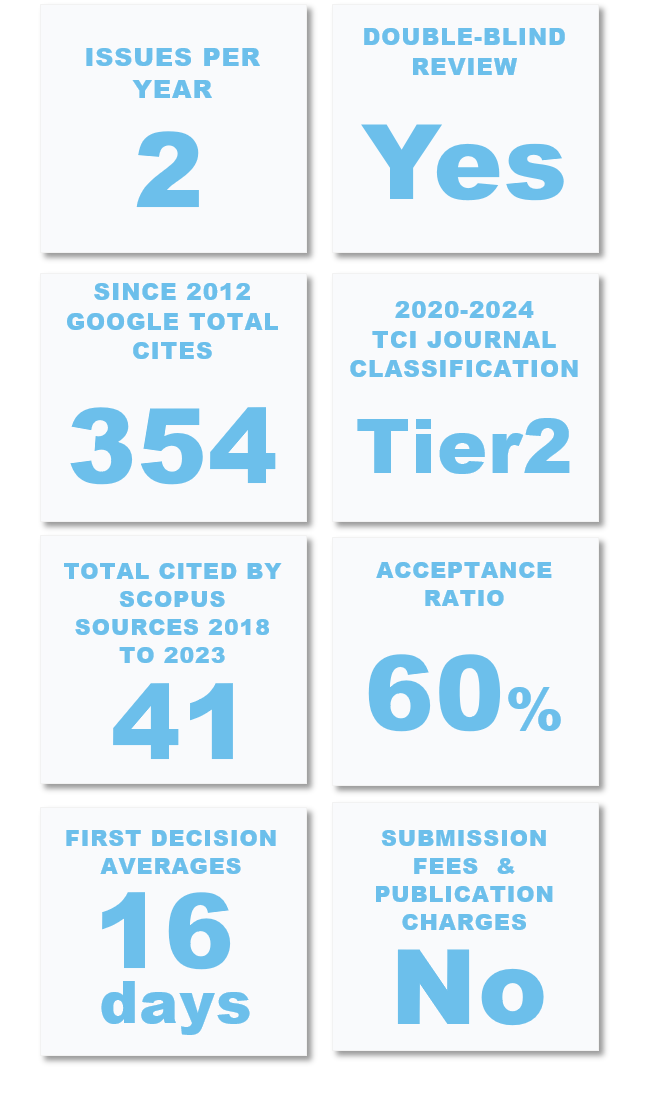Technical Approaches of PM2.5 Control for Spatial Design in Thailand
Keywords:
PM2.5 controls, design approaches, Thailand situations, air purifier techniquesAbstract
According to PM2.5 situation in Thailand, the monitoring of dust concentration has been exceeding 100 μg/m3 for longer a month period. This level is harmful to all local livings standardized by National Ambient Air Quality standards (NAAQs) and World Health Organization (WHO). However, this problem is specific to location in terms of tropical climate, geographical land, existing policy and people behaviours. Social intervention reviews are separately concerned in another research part of study series. Thus, this paper aims to find suitable PM2.5 purification and techniques matched to tropical climate and high concentration conditions. Environmental factors, probably affect PM2.5 situations, are considered in priority. Systematic reviews of different techniques are literally analysed and synthesized for optimum benefits to local applicants, further research and case studies in teaching class. The results are scoped to three levels of living conditions from outdoor situation for landscape study to architectural integration for architecture study and indoor applicable functions for interior designer study. For outdoor approaches, well connectivity of information in terms of Internet of Things (IoTs) and smart satellite technology are mainly concerned to provide accuracy and reliability, when planting landscape in city is proved to reduce PM2.5. In case of architectural scale, the details of technical and chemical approaches can support physical approaches for design. Lastly, interior scale concerning of air pollution is exemplified for further space design. Suggestions, installations and cautions of applications are perhaps included in each specific session.
Downloads
References
Abdo, P., Huynh, B. P., Irga, P. J., & Torpy, F. R. (2019). Evaluation of air flow through an active green wall biofilter. Urban Forestry & Urban Greening, 41, 75-84. doi:https://doi.org/10.1016/j.ufug.2019.03.013
Air Quality and Noise Management Bureau. (2019, 10th February). Thailand’s air quality and situation reports. Available: http://air4thai.pcd.go.th/webV2/download.php
Bin, H., Yang, Y., Lei, Z., Ao, S., Cai, L., Linjun, Y., & Roszak, S. (2018). Experimental and DFT studies of PM2.5 removal by chemical agglomeration. Fuel, 212, 27-33. doi:https://doi.org/10.1016/j.fuel.2017.09.121
Brilli, F., Fares, S., Ghirardo, A., de Visser, P., Calatayud, V., Muñoz, A., . . . Menghini, F. (2018). Plants for Sustainable Improvement of Indoor Air Quality. Trends in Plant Science, 23(6), 507-512. doi:https://doi.org/10.1016/j.tplants.2018.03.004
Buccolieri, R., Jeanjean, A. P. R., Gatto, E., & Leigh, R. J. (2018). The impact of trees on street ventilation, NOx and PM2.5 concentrations across heights in Marylebone Rd street canyon, central London. Sustainable Cities and Society, 41, 227-241. doi:https://doi.org/10.1016/j.scs.2018.05.030
Castorani, V., Rossi, M., Germani, M., Mandolini, M., & Vita, A. (2018). Life Cycle Assessment of Home Smart Objects: Kitchen Hood Cases. Procedia CIRP, 69, 499- 504. doi:https://doi.org/10.1016/j.procir.2017.11.113
Chang, K.-L., Amesho, K. T. T., Lin, Y.-C., Jhang, S.-R., Chou, F.-C., & Chen, H.-C. (2019). Effects of atmospheric- plasma system on energy efficiency improvement and emissions reduction from a diesel engine. Journal of Environmental Management, 234, 336-344. doi:https://doi.org/10.1016/j.jenvman.2019.01.017
Chen, H., Tang, X., Liang, C., & Wu, X. (2018). Attapulgite suspension mitigates fine particulate matter (PM2.5) emission from coal combustion in fluidized bed. Journal of Environmental Management, 209, 245-253. doi:https://doi.org/10.1016/j.jenvman.2017.12.072
Chen, L., Liu, C., Zou, R., Yang, M., & Zhang, Z. (2016). Experimental examination of effectiveness of vegetation as bio-filter of particulate matters in the urban environment. Environmental Pollution, 208, 198-208. doi:https://doi.org/10.1016/j.envpol.2015.09.006
Chien, W.-C., Lai, C.-F., Cho, H.-H., & Chao, H.-C. (2018). A SDN-SFC-based service-oriented load balancing for the IoT applications. Journal of Network and Computer Applications, 114, 88-97. doi:https://doi.org/10.1016/j.jnca.2018.04.009
Chu, Y., Xu, P., Yang, Z., & Li, W. (2017). Existing building retrofitting for Indoor PM2.5 Concentration Control on Smog Days: Case study in China. Procedia Engineering, 205, 3222-3227. doi:https://doi.org/10.1016/j.proeng.2017.10.290
Fedotov, V., & Afanasiev, A. (2018). Concept of air environment cleaning of natural and technogenic systems of motor transport using mobile devices. Transportation Research Procedia, 36, 179-184. doi: https://doi.org/10.1016/j.trpro.2018.12.061
Feng, X., Fu, T.-M., Cao, H., Tian, H., Fan, Q., & Chen, X. (2019). Neural network predictions of pollutant emissions from open burning of crop residues: Application to air quality forecasts in southern China. Atmospheric Environment, 204, 22-31. doi:https://doi.org/10.1016/j.atmosenv.2019.02.002
Geng, G., Murray, N. L., Chang, H. H., & Liu, Y. (2018). The sensitivity of satellite-based PM2.5 estimates to its inputs: Implications to model development in data-poor regions. Environment International, 121, 550-560. doi:https://doi.org/10.1016/j.envint.2018.09.051
Guo, T., Wang, C., Yang, X., & Sun, X. (2017). Development and performance of sand fog seal with cooling and air purification effects. Construction and Building Materials, 141, 608-618. doi:https://doi.org/10.1016/j.conbuildmat.2017.03.003
Haorui, J., Manhao, L., Ge, H., Li, Z., & Yu, D. (2018). Quality stability evaluation model based on intelligent control. IFAC-PapersOnLine, 51(32), 99-104. doi:https://doi.org/10.1016/j.ifacol.2018.11.361
He, Q., & Huang, B. (2018). Satellite-based high-resolution PM2.5 estimation over the Beijing-Tianjin-Hebei region of China using an improved geographically and temporally weighted regression model. Environmental Pollution, 236, 1027-1037. doi:https://doiorg/10.1016/j.envpol.2018.01.053
Hoeflinger, W., & Laminger, T. (2019). PM2.5 or respirable dust measurement and their use for assessment of dust separators. Journal of the Taiwan Institute of Chemical Engineers, 94, 53-61. doi:https://doi.org/10.1016/j.jtice.2017.07.035
Huang, W.-R., He, Z., Wang, J.-L., Liu, J.-W., & Yu, S.-H. (2019). Mass Production of Nanowire-Nylon Flexible Transparent Smart Windows for PM2.5 Capture. iScience, 12, 333-341. doi:https://doi.org/10.1016/j.isci.2019.01.014
Jaworek, A., Marchewicz, A., Sobczyk, A. T., Krupa, A., & Czech, T. (2017). Two-stage electrostatic precipitator with co- and counter-flow particle prechargers. Journal of Electrostatics, 87, 180-194. doi:https://doi.org/10.1016/j.elstat.2017.04.012
Jaworek, A., Marchewicz, A., Sobczyk, A. T., Krupa, A., & Czech, T. (2018). Two-stage electrostatic precipitators for the reduction of PM2.5 particle emission. Progress in Energy and Combustion Science, 67, 206-233. doi: https://doi.org/10.1016/j.pecs.2018.03.003
Jianan, W., Xue, W., Tingyu, Z., & Yi, Z. (2018). Experimental study on the impact of electrostatic effect on the movement of charged particles. Journal of Electrostatics, 94, 14-20. doi:https://doi.org/10.1016/j.elstat.2018.04.012
Kawamoto, H., & Hashime, S. (2018). Practical performance of an electrostatic cleaning system for removal of lunar dust from optical elements utilizing electrostatic traveling wave. Journal of Electrostatics, 94, 38-43. doi:https://doi.org/10.1016/j.elstat.2018.05.004
Lai, Y., & Kontokosta, C. E. (2019). The impact of urban street tree species on air quality and respiratory illness: A spatial analysis of large-scale, high-resolution urban data. Health & Place, 56, 80-87. doi:https://doi.org/10.1016/j.healthplace.2019.01.016
Lettieri, M., Colangiuli, D., Masieri, M., & Calia, A. (2019). Field performances of nanosized TiO2 coated limestone for a self-cleaning building surface in an urban environment. Building and Environment, 147, 506-516. doi:https://doi.org/10.1016/j.buildenv.2018.10.037
Li, J., Wang, N., Wang, J., & Li, H. (2018). Spatiotemporal evolution of the remotely sensed global continental PM2.5 concentration from 2000-2014 based on Bayesian statistics. Environmental Pollution, 238, 471- 481. doi:https://doi.org/10.1016/j.envpol.2018.03.050
Liu, C., He, L., Pi, D., Zhao, J., Lin, L., He, P., . . . You, Y. (2019). LIDAR analyzing the transmission of PM2.5 in Shenzhen with LIDAR data and four- dimensional flux method. Physics and Chemistry of the Earth, Parts A/B/C. doi: https://doi.org/10.1016/j.pce.2019.04.001
Liu, J., Li, W., & Wu, J. (2018). A framework for delineating the regional boundaries of PM2.5 pollution: A case study of China. Environmental Pollution, 235, 642-651. doi:https://doi.org/10.1016/j.envpol.2017.12.064
Lu, S., Yang, X., Li, S., Chen, B., Jiang, Y., Wang, D., & Xu, L. (2018). Effects of plant leaf surface and different pollution levels on PM2.5 adsorption capacity. Urban Forestry & Urban Greening, 34, 64-70. doi:https://doi.org/10.1016/j.ufug.2018.05.006
Ma, S., Zhang, M., Nie, J., Tan, J., Yang, B., & Song, S. (2019). Design of double-component metal–organic framework air filters with PM2.5 capture, gas adsorption and antibacterial capacities. Carbohydrate Polymers, 203, 415-422. doi:https://doi.org/10.1016/j.carbpol.2018.09.039
Pisoni, E., Albrecht, D., Mara, T. A., Rosati, R., Tarantola, S., & Thunis, P. (2018). Application of uncertainty and sensitivity analysis to the air quality SHERPA modelling tool. Atmospheric Environment, 183, 84-93. doi:https://doi.org/10.1016/j.atmosenv.2018.04.006
Ren, J., & Liu, J. (2019). Fine particulate matter control performance of a new kind of suspended fan filter unit for use in office buildings. Building and Environment, 149, 468-476. doi:https://doi.org/10.1016/j.buildenv.2018.12.047
Soh, A., Dubey, S., Hedlund, K., & Kaushal, J. (2019). Field Testing of General Ventilation Devices and Systems for Particles Removal Efficiency and Pressure Drop. Energy Procedia, 158, 4465-4470. doi:https://doi.org/10.1016/j.egypro.2019.01.767
Still, D. K., Bentson, S., Murray, N., Andres, J., Yue, Z., & MacCarty, N. A. (2018). Laboratory experiments regarding the use of filtration and retained heat to reduce particulate matter emissions from biomass cooking. Energy for Sustainable Development, 42, 129- 135. doi:https://doi.org/10.1016/j.esd.2017.09.011
Taylor, J., Shrubsole, C., Symonds, P., Mackenzie, I., & Davies, M. (2019). Application of an indoor air pollution metamodel to a spatially-distributed housing stock. Science of The Total Environment, 667, 390-399. doi: https://doi.org/10.1016/j.scitotenv.2019.02.341
Tsang, C. H. A., Li, K., Zeng, Y., Zhao, W., Zhang, T., Zhan, Y., . . . Huang, H. (2019). Titanium oxide based photocatalytic materials development and their role of in the air pollutants degradation: Overview and forecast.Environment International, 125, 200-228. doi:https://doi.org/10.1016/j.envint.2019.01.015
Wang, J., Li, H., & Lu, H. (2018). Application of a novel early warning system based on fuzzy time series in urban air quality forecasting in China. Applied Soft Computing, 71, 783-799. doi:https://doi.org/10.1016/j.asoc.2018.07.030
Wang, F., Zhang, E., & Wang, J. (2017). A Study of Particle Deposition in Ventilation Ducts With Convex or Con- cave Wall Cavity. Procedia Engineering, 205, 3285-3292. doi:https://doi.org/10.1016/j.proeng.2017.10.336
Wongwatcharapaiboon, J. (2020). Review Article: Toward Future Particulate Matter Situations in Thailand from Supporting Policy, Network and Economy. Future Cities and Environment, 6(1), 1. DOI: http://doi.org/10.5334/fce.79
Xiong, W., Lin, Z., Zhang, W., Chen, T., & Zhao, C. (2018). Experimental and simulation studies on dust loading performance of a novel electrostatic precipitator with dielectric barrier electrodes. Building and Environment, 144, 119-128. doi:https://doi.org/10.1016/j.buildenv.2018.08.008
Xu, Y., Ho, H. C., Wong, M. S., Deng, C., Shi, Y., Chan, T.-C., & Knudby, A. (2018). Evaluation of machine learning techniques with multiple remote sensing datasets in estimating monthly concentrations of ground-level PM2.5. Environmental Pollution, 242, 1417-1426. doi:https://doi.org/10.1016/j.envpol.2018.08.029
Zhang, X., Ma, J., Li, A., Lv, W., Zhang, W., & Li, D. (2019). Ventilation for subway stations with adjustable platform doors created by train-induced unsteady airflow. Building and Environment, 152, 87-104. doi: https://doi.org/10.1016/j.buildenv.2019.02.001
Zhao, L., Jiang, L., Li, H., Hu, C., Sun, J., Li, L., . . . Zhou, C. (2018). Synthesis and characterization of silver- incorporated calcium phosphate antibacterial nanocomposites for mask filtration material. Composites Part B: Engineering, 153, 387-392. doi:https://doi.org/10.1016/j.compositesb.2018.09.004

Downloads
Published
How to Cite
Issue
Section
License
Copyright (c) 2021 International Journal of Building, Urban, Interior and Landscape Technology (BUILT)

This work is licensed under a Creative Commons Attribution-NonCommercial-NoDerivatives 4.0 International License.











